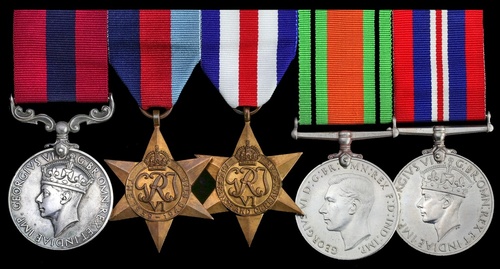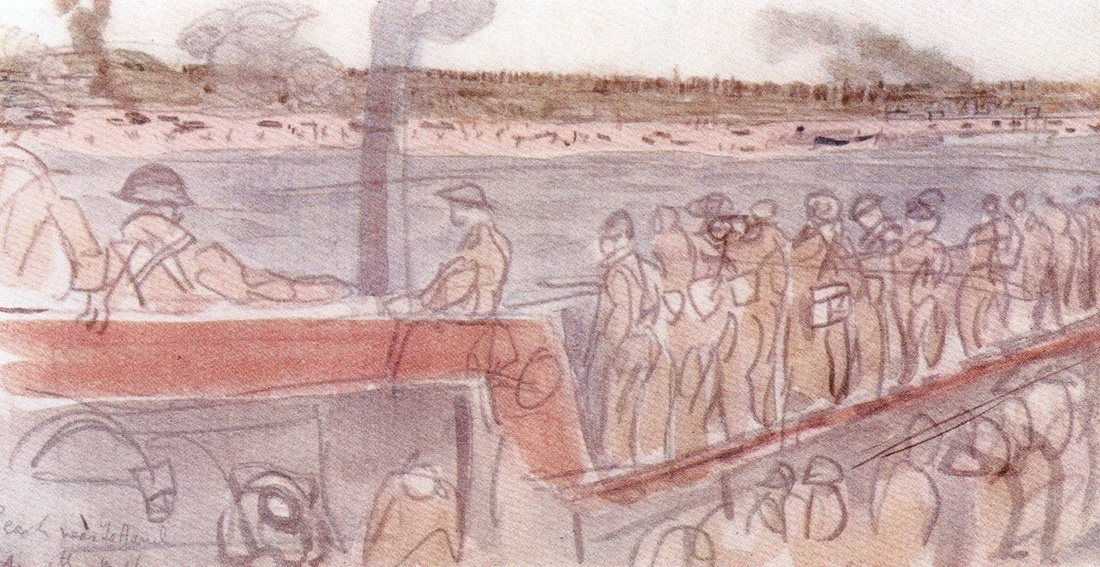Auction: 18001 - Orders, Decorations and Medals
Lot: 586
An outstanding Second World War Normandy operations D.C.M. group of five awarded to Acting Corporal R. E. Millington, Gloucestershire Regiment, an immediate - and regimentally unique - award for the North-West Europe campaign
Having come ashore with the 2nd Battalion on D-Day - and survived the 'inferno of confused battle' that ensued at Thurly-Harcourt - he displayed magnificent courage in 'neutralising' a line of Spandau posts outside Le Havre in September 1944, a feat achieved at the point of the bayonet and after traversing 300 yards of fire swept ground
Distinguished Conduct Medal, G.VI.R. (3653499 A. Cpl. R. E. Millington, Glouc. R.); 1939-45 Star; France and Germany Star; Defence and War Medals 1939-45, good very fine or better (5)
D.C.M. London Gazette 21 December 1944. The original recommendation for an immediate award states:
'Corporal Millington was commanding the leading section of No. 7 Platroon, 'A' Company, in the attack on the outer defences of Le Havre on 10 September 1944. His platoon was working with a troop of tanks, Crocodiles and AVRE, leading the assault on post No. 3 of the position.
There was a hold up passing through the gap due to one 'Croc' going up on a mine and Corporal Millington found his section on the enemy side of the gap with the armoured support not yet through. He had been ordered to push on as fast as possible and to get the fullest effect from the concentrations.
Without further orders and with great dash, he led his section without immediate support straight for the objective against a line of Spandau posts at the edge of a wood. In order to reach these posts he had to traverse 300 yards of open country in the face of heavy DF and small arms fire. He reached his objective and neutralised the posts.
By his outstanding bravery, determination and complete disregard for his personal safety, Corporal Millington was a great inspiration to the men under his command. His prompt and fearless action maintained the momentum of the Battalion attack and was responsible for him reaching his objective and capturing 20 prisoners, who only gave themselves up when faced by a section of determined men with fixed bayonets.'
Robert Edward Millington landed in Normandy on D-Day as a member of No. 7 Platoon, 'A' Company, 2nd Battalion, Gloucestershire Regiment.
Advancing south in support of the 7th 'Desert Rats' Armoured Division, the 2nd Gloucesters saw extensive action in the period leading up to Millington's D.C.M. exploits in September.
The regimental history - Cap of Honour - describes costly encounters at Tilly and Lingevres before the end of June; another heavily contested attack on Saint Germain d'Etcot in late July - where the pioneers cleared 300 horse-shoe type mines and eight booby-traps - and the crossing of the River Orne under a heavy fire.
'An inferno of confused battle'
Then came the bitterest of actions at Thurly-Harcourt in August, in which Millington's 'A' Company was heavily engaged:
'As soon as 'A' Company were in the open they came under considerable Spandau and machine-gun fire. In spite of this one platoon reached its objective, a small bridge to the north of the town, and the Pioneer Platoon removed all mines, although they had to work under such heavy fire that the whole platoon became casualties … soon the town was burning, an inferno of confused battle … the enemy brought 88mm. guns into operation, as well as heavy mortars … the Squadron tanks, unable to get into the town, gave valuable long-range support, and fired until the barrels of their guns were red-hot. At seven in the evening, after seven hours of the most strenuous fighting, the Battalion was withdrawn; it was obvious Thurly-Harcourt could not be taken until the high ground overlooking it had been cleared.'
As Captain R. C. Nash, the Adjutant, concluded, 'for sheer noise and stonking' the battle was one of the worst of the campaign. That the Gloucesters 'got as far as they did in that death-trap says a great deal for the leadership of the commanders and the girt and determination of the men. After the battle, the Squadron Commander of the 34th Armoured Brigade summed up the efforts of the regiment by saying that never before had he seen men fight with such bravery and determination against such fearful odds.'
With the failure of our armour to get through - and the excess of Spandau fire - the action at Thurly-Harcourt was a foretaste of events to come at Le Havre; meanwhile, Millington and his comrades endured another bruising encounter at Epaignes, the Battalion suffering 53 casualties.
Le Havre and beyond
By early September 1944, positions had been taken up on the high ground outside Le Havre, with planning and patrolling being set in motion for the forthcoming assault on the 10th.
On that date, as cited above, Millington found himself out on a limb, supporting armour having failed to keep up with his platoon. Without that armour - 'flail' tanks for mine clearance and the AVRE flame-throwing variety for troop clearance - he might have sat tight to await further support. Instead he led his platoon over 300 yards of open country and stormed his objective - a line of Spandau posts - at the point of the bayonet. It was an inspiring sight to those who witnessed it and added 20 prisoners to the Battalion's eventual bag of 1500 enemy troops. He was awarded an immediate D.C.M., the only such distinction won by 2nd Gloucesters in the North-West Europe campaign.
The Battalion's subsequent part in the campaign was equally impressive, from the advance through Belgium to the Mass, and beyond. Several bitterly cold months at Nijmegen followed - a 'difficult winter in water and mud' - prior to the final assault on Arnhem in April 1945. On that occasion, Millington's 'A' Company crossed the river Ijssel in assault boats at night and captured an old Dutch silk factory which the Germans had fortified; so, too, 60 enemy troops who were found cowering in the cellars.
Finally, in early May, the Battalion had to deal with a force of fanatical Dutch S.S. troops at Bennekom, bringing total casualties in the campaign to 13 officers and 132 other ranks killed, and 27 officers and 564 other ranks wounded.
Subject to 20% VAT on Buyer’s Premium. For more information please view Terms and Conditions for Buyers.
Sold for
£9,000







